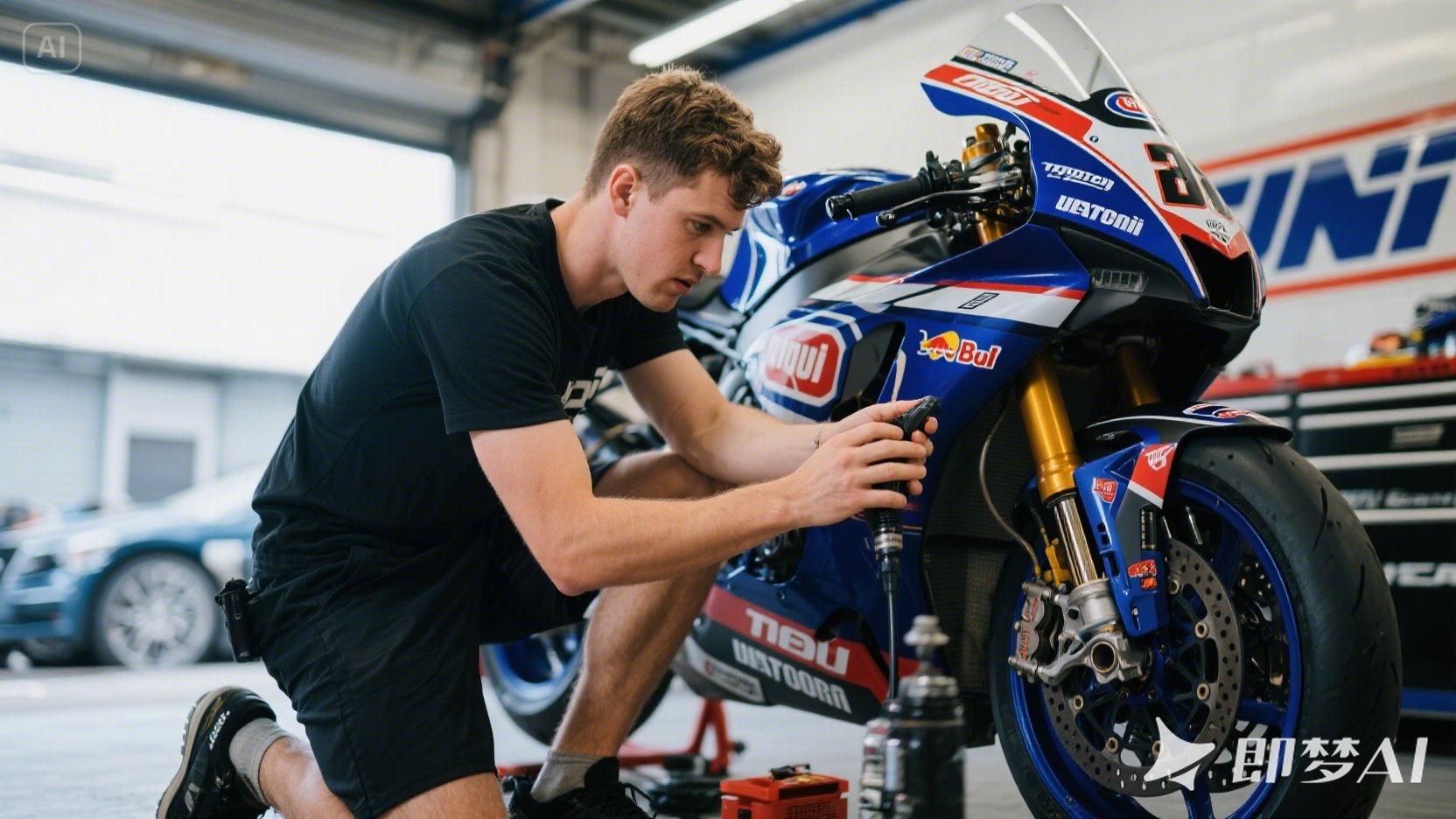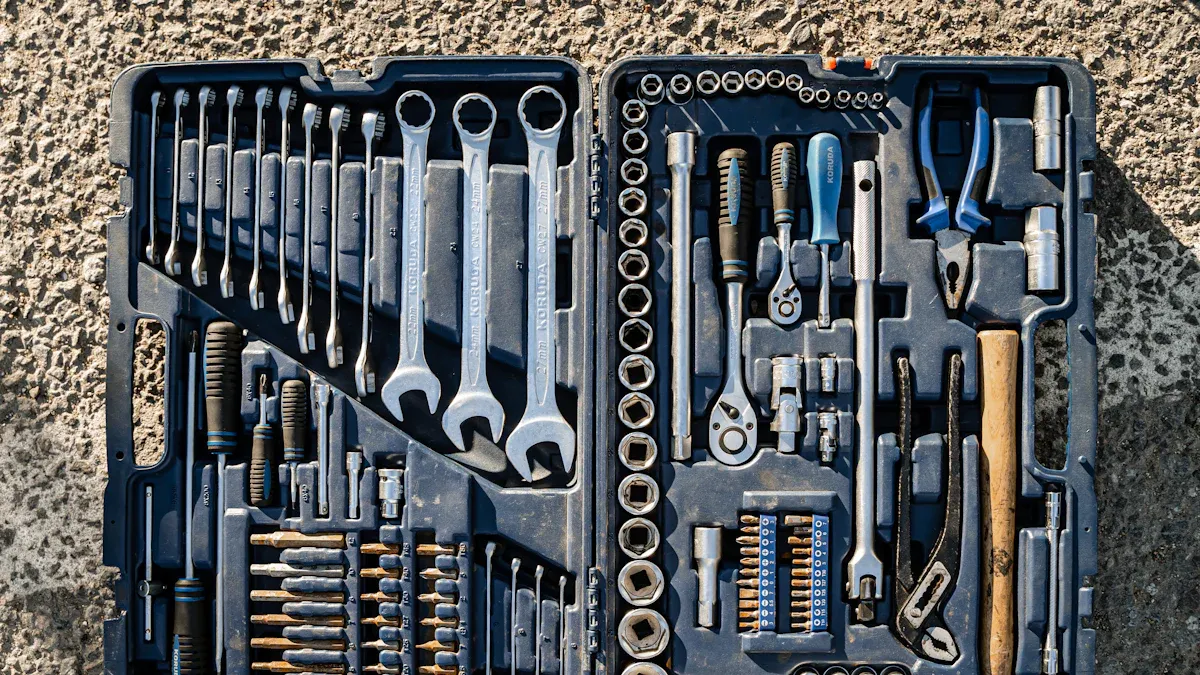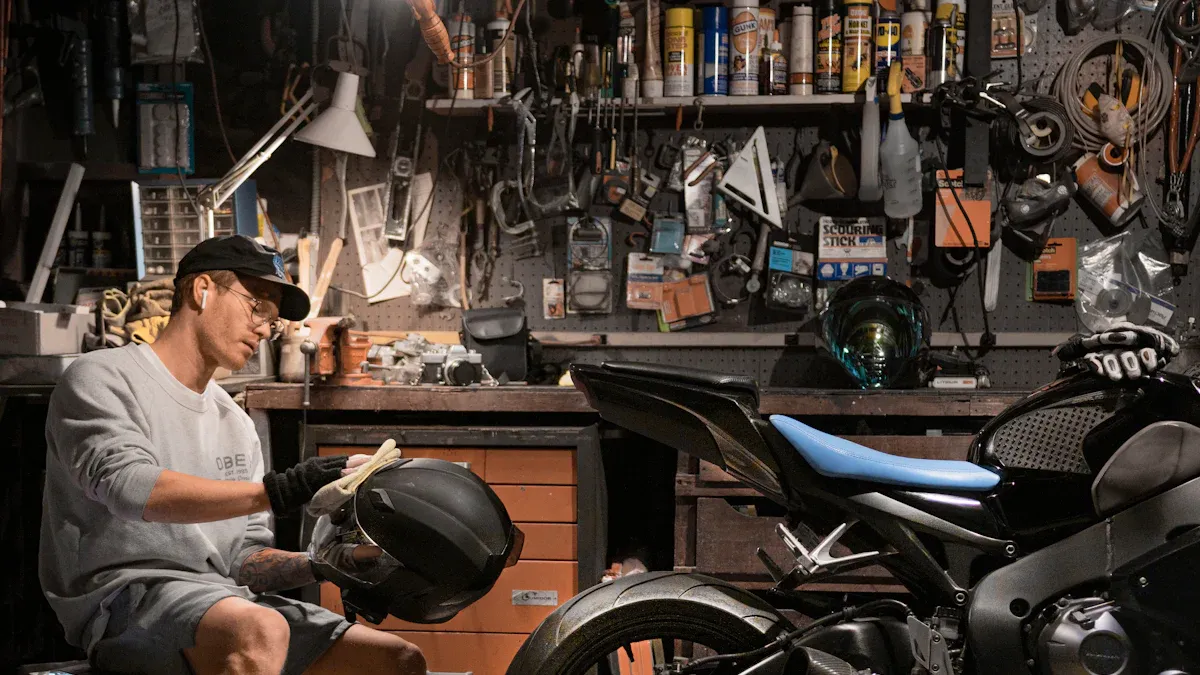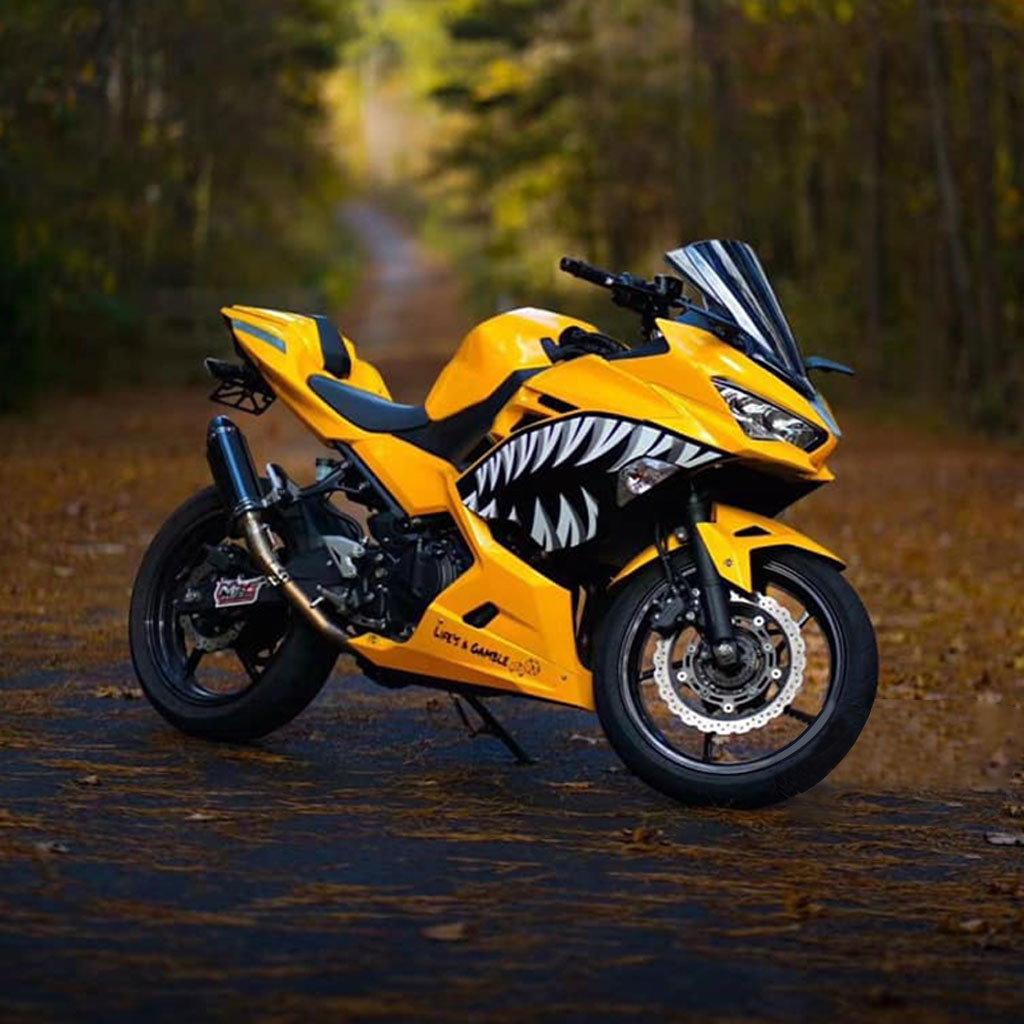Beginner's Guide to Caring for Your First Motorcycle

Taking care of your first motorcycle isn’t just about looks. It’s also about staying safe and having fun riding. Did you know good maintenance can prevent crashes and injuries? Many new riders forget easy tasks that avoid big repairs. Build good habits now, and your bike will last longer.
Key Takeaways
Check your motorcycle's tire pressure and tread often for safety. Change tires every 5-7 years, even if they seem okay.
Wear safety gear, like a DOT-approved helmet, to avoid serious injuries in crashes.
Do a safety check before riding using the T-CLOCS method. Look at tires, controls, lights, fluids, chassis, and stands each time.
Essential Maintenance Tasks for Your First Motorcycle

Taking care of your first motorcycle might seem hard at first. But breaking it into small tasks makes it easier to handle. Here are some simple tips to keep your bike safe and running well.
Checking and Maintaining Tires
Tires are the only part of your bike touching the road. This makes keeping them in good condition very important. Check your tires often for the right pressure and tread depth. Low pressure can make riding unsafe, and worn treads can cause slipping, especially on wet roads. Use a tire pressure gauge to match the levels to the manufacturer’s advice.
Did you know tires should be replaced if wear bars show or cracks appear? Even if the tread looks fine, replace them every 5-7 years because rubber wears out over time. Look for the DOT code on the sidewall to check the tire’s age. Watching these details helps avoid big repairs and keeps your rides safer.
Pro Tip: Always check your tires before riding, especially if you’re new. It’s a quick step that can prevent problems on the road.
Inspecting the Battery and Electrical Components
A dead battery can leave you stuck, so check it often. Look for rust on the terminals and clean it with baking soda and water if needed. Make sure the connections are tight. If your bike hasn’t been used for a while, use a trickle charger to keep the battery full.
Test your electrical parts like the horn, lights, and signals. These help you stay visible and communicate with other drivers. Broken electrical systems can cause accidents, so don’t skip this step.
Monitoring and Replacing Fluid Levels
Fluids are like the blood of your motorcycle. Engine oil, brake fluid, and coolant keep your bike working well. Check them often and add more if needed. Dirty or low fluids can overheat or damage your engine.
Some bikes have sensors that check fluid levels for you. These sensors catch problems early and prevent sudden breakdowns. If your bike doesn’t have this, check fluids yourself every few weeks.
Feature | Description |
|---|---|
Real-Time Monitoring | Watches engine oil levels and quality for timely fixes. |
Advanced Sensors | Uses smart tech to check oil in small engines. |
Proactive Maintenance | Helps with early oil changes and fixes, avoiding breakdowns. |
Cleaning and Adjusting the Chain
The chain moves power from the engine to the back wheel. Keeping it clean and adjusted is important for your bike’s performance. Dirt can build up and wear out the chain faster. Use a chain cleaner and brush to clean it, then add lubricant.
Clean and oil your chain every 500 miles or after riding in rain. Check the tension too. A loose chain can fall off, and a tight one can harm the engine. Taking care of the chain makes rides smoother and protects the sprockets.
Quick Tip: Unsure about chain tension? Check your manual or ask an expert. Companies like Nicefairings can also help with bike care tips.
Inspecting Lights and Indicators
Lights and signals help you communicate on the road. Before riding, check your headlights, brake lights, and turn signals. Replace any broken bulbs right away. Clean the lenses so they shine brightly, especially at night or in bad weather.
Broken lights make it harder for others to see you and can cause legal trouble. Regular checks keep you safe and follow traffic rules.
Reminder: Keep spare bulbs in your toolkit. They’re cheap and can save you trouble if a light goes out.
By following these tips, your first motorcycle will stay in great shape. You’ll also enjoy safer and more reliable rides. A little care now can stop bigger problems later.
Safety Tips for Your First Motorcycle Ride
Riding your first motorcycle is thrilling, but safety comes first. Whether you're riding in the city or on highways, these tips will help you stay safe and enjoy your ride.
Wearing Protective Gear
Protective gear keeps you safe during accidents. A helmet is the most important item. It lowers the chance of head injuries by 69% and reduces deaths by 37%. Always pick a helmet that meets DOT or ECE safety rules. Full-face helmets protect your head, face, and chin.
Don’t just wear a helmet. Use a strong jacket, gloves, pants, and boots made for riding. These protect you from scrapes, flying debris, and bad weather. Choose gear with safety features like padding and reflective strips to be more visible.
Quick Tip: States with helmet laws see helmet use rise from under 50% to over 90%. Even if your state doesn’t require helmets, wearing one can save your life.
Staying Visible on the Road
Motorcycles are smaller than cars, so drivers may not see you. Wear bright-colored clothes or reflective vests to stand out. Add extra lights to your bike, like LED strips, to improve visibility at night.
Ride where drivers can see you. Avoid blind spots and pick a lane position that makes you noticeable. At intersections, move slightly within your lane to catch drivers’ attention. This small action can prevent crashes.
Proven Visibility Tips:
Bright gear and reflective items lower crash risks.
Extra lights make you easier to see in the dark.
Riding with others makes you more noticeable to drivers.
Reminder: Being visible keeps you safer. Make sure others can easily spot you on the road.
Practicing Defensive Driving
Defensive driving means staying alert and predicting what others might do. Assume drivers don’t see you. Keep a safe distance from cars, especially large trucks with big blind spots. Watch for sudden moves like lane changes or turns without signals.
Focus on the road and look out for dangers like potholes, debris, or distracted drivers. Don’t weave through traffic or ride too close to other vehicles. Defensive driving isn’t just reacting to problems—it’s about avoiding them.
Did You Know? Defensive driving greatly lowers your chances of accidents. It’s a key skill for new riders to learn.
Conducting a Pre-Ride Safety Check
Before riding, take a few minutes to check your motorcycle. A quick safety check can stop problems and keep you safe. Use the T-CLOCS method to remember what to inspect:
T-CLOCS Checklist | What to Check |
|---|---|
Tires/Wheels | Look at tire pressure and tread depth. |
Controls | Test brakes, throttle, and clutch. |
Lights/Electrics | Check headlights, signals, and horn. |
Oil/Fluids | Inspect engine oil, brake fluid, and coolant. |
Chassis | Look over the frame and suspension. |
Stands | Make sure the kickstand works well. |
A digital checklist can help you stay organized and not miss anything. Regular checks, like testing brakes and lights, keep your bike running well and lower accident risks.
Pro Tip: A pre-ride check takes only a few minutes but can prevent big problems later.
By following these safety tips, you’ll feel ready and confident for your first ride. Safety isn’t just about avoiding accidents—it’s about enjoying the freedom of riding with peace of mind.
Seasonal Care for Your Motorcycle

Getting Ready for Summer Rides
Riding in summer is fun, but heat can cause problems. Hot weather may raise tire pressure, so check it often. Look at the tread too, since worn tires are risky on hot roads.
Drink plenty of water during long rides. Being thirsty can make you less alert. Plan breaks and avoid riding when it’s hottest outside. Check your bike’s fluids like coolant and oil. Heat makes them dry up faster, so refill them when needed.
Tip: Wear light gear with vents and reflective strips. It keeps you cool and easy to see.
Preparing Your Motorcycle for Winter
Winter can be hard on your bike. Clean it well before cold weather starts. Dirt and water can cause rust, so use silicone spray on plastic and oil on metal parts. Keep the battery charged with a smart charger, as cold drains it quickly.
Add fuel stabilizer to stop gas from going bad during storage. Store your bike indoors if you can. If not, cover it with a waterproof sheet to protect it from snow. Change the oil and fluids to avoid engine damage.
Store your bike in a safe, dry place.
Replace old fluids to stop rust.
Use plugs to block pests from entering your bike.
Riding Safely in Rainy Weather
Rain makes roads slippery, so be extra careful. Check your tires to ensure they have enough tread. Worn tires make stopping and turning harder. Ride slower and avoid sudden moves to stay in control.
Rain can also make it hard to see. Clean your lights and wear bright or reflective clothes so others notice you. Waterproof gear keeps you dry and focused. Don’t ride through deep puddles—they might hide dangers like potholes.
Reminder: Test your brakes after riding through water. Wet brakes may not work well.
Changing Maintenance for Each Season
Different seasons affect your bike in unique ways. In summer, watch tire pressure and cooling systems. Winter needs focus on the battery, anti-freeze, and rust prevention. Spring brings mud, so clean your bike and check for winter damage.
Season | Problems | |
|---|---|---|
Summer | Heat, dehydration, bike issues | Drink water, plan routes, check weather |
Winter | Ice, snow, cold | Check gear, plan safe routes, have emergency contacts |
Spring | Mud, rain, gravel | Watch weather, avoid hazards, clean bike often |
Adjusting your care routine for each season keeps your bike running well and keeps you safe all year.
Long-Term Care and Storage for Your Motorcycle
Regular Cleaning and Polishing
Cleaning your motorcycle isn’t just about making it look nice. Dirt and moisture can cause rust and damage over time. Washing and polishing your bike often keeps it in good shape. Use a mild cleaner and a soft cloth to remove dirt. After cleaning, apply polish to protect against water and sunlight.
Why clean and polish often?
It keeps your bike looking new.
It stops rust and makes your bike last longer.
Polishing protects from rain and sun damage.
Tip: Buy a good motorcycle care kit. It helps protect your bike and keeps it looking great.
Proper Storage During Off-Season
Storing your bike the right way during the off-season is important. Follow these steps to keep it safe:
Store it in a dry, safe place to avoid moisture.
Wash and wax it to protect the paint.
Add fuel stabilizer to keep the gas fresh.
Change the oil to protect the engine.
Use a battery tender or remove the battery to keep it charged.
Inflate the tires and use a center stand to prevent flat spots.
Reminder: If you can’t store your bike indoors, cover it with a waterproof sheet. This keeps it safe from rain and snow.
Scheduling Routine Servicing
Regular servicing helps avoid big repairs and keeps your bike running well. Use an app to track when to service your bike. It reminds you about oil changes, brake checks, and other tasks. These apps also help you plan for costs and track your bike’s history. Servicing improves how your bike runs and increases its resale value.
Pro Tip: Follow the service schedule in your owner’s manual. It’s the best way to keep your bike reliable.
Preventing Rust and Corrosion
Rust can ruin your bike if you don’t stop it early. Keep your motorcycle clean and dry to avoid rust. Wax metal parts and use silicone spray on plastic ones. Pay extra attention to the exhaust and mufflers—spray them with oil and cover them to block moisture. Check for rust often and fix it right away.
Quick Tip: After riding in the rain, dry your bike completely to stop rust from forming.
By following these care tips, your motorcycle will stay in great shape for years. A little work now prevents bigger problems later and ensures every ride is smooth and safe.
Caring for your first motorcycle isn’t just a task. It helps you stay safe and enjoy riding more. These tips help new riders keep their bikes in great condition. Build smart habits now to make every ride special. Enjoy the journey ahead!
FAQ
How often should you check your motorcycle’s tire pressure?
You should check your tire pressure at least once a week. Regular checks ensure safe rides and prevent uneven tire wear.
Tip: Use a digital tire pressure gauge for quick and accurate readings.
What’s the best way to clean your motorcycle chain?
Use a chain cleaner and a soft brush. After cleaning, apply a high-quality chain lubricant to keep it running smoothly.
Can you store your motorcycle outside during winter?
Yes, but use a waterproof cover to protect it from snow and rain. Storing it indoors is better to prevent rust and weather damage.
Reminder: Add a fuel stabilizer if storing your bike for more than a month.
See Also
Tips for Ensuring Safety During Your Initial Motorcycle Journey
Key Advice for Crafting the Motorcycle of Your Dreams
How to Care for and Clean Your Motorcycle Fairings
Steps to Prepare Your Motorcycle for Winter Weather
Important Safety Guidelines for Riders Using Motorcycle Fairings

